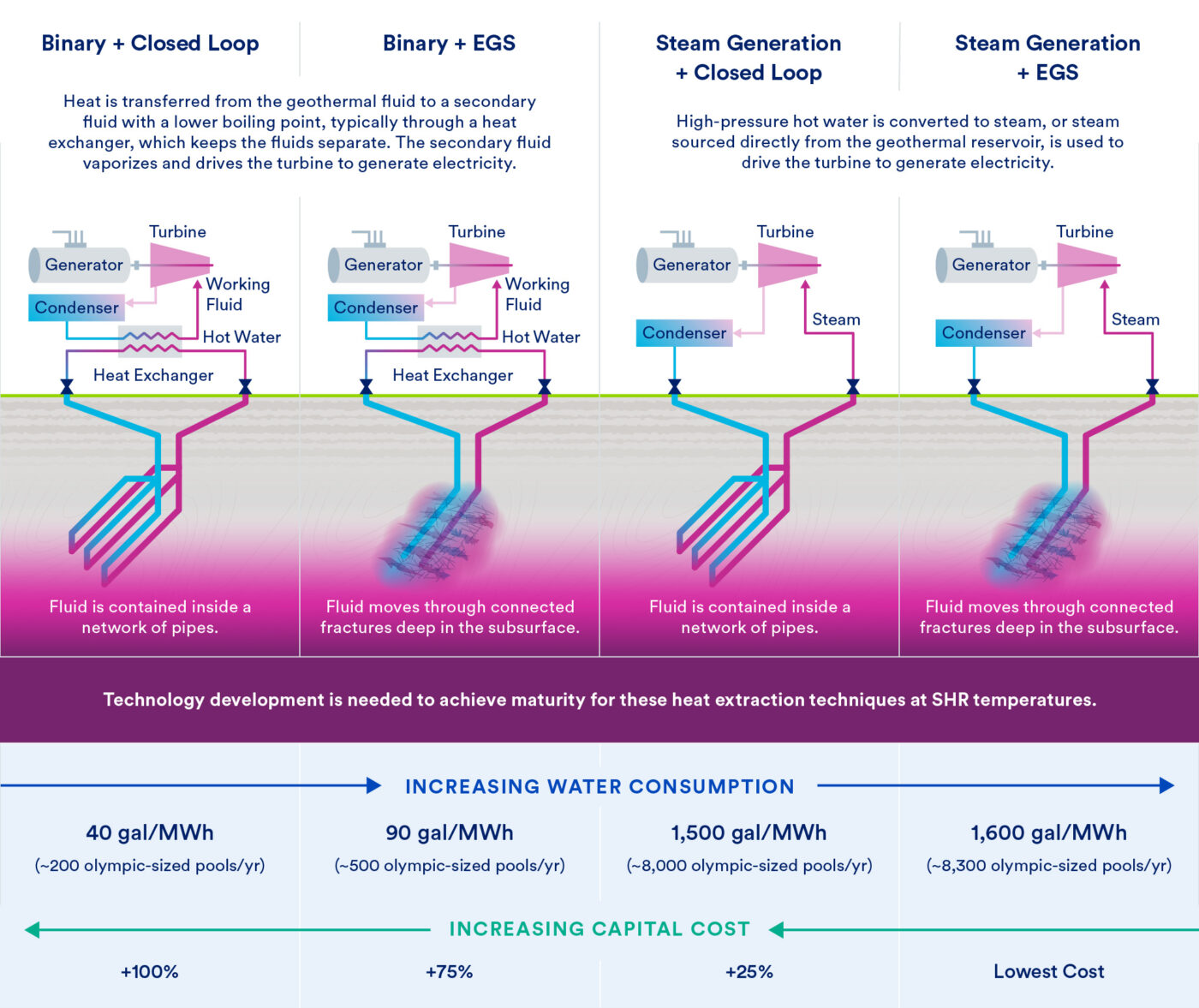
An introduction to the next clean energy frontier: Superhot rock and water-based binary cycles
This blog is part of a series exploring and explaining the science behind next-generation geothermal, with a special focus on Superhot Rock Geothermal, through a curated tour of influential technical and academic papers. This edition highlights key features of the 2025 Conference Proceeding from the Stanford Workshop on Geothermal Reservoir Engineering by Daniel Dichter Water-Based Geothermal Binary Cycles. The full blog series, in addition to their reference reports, can be found at the Superhot Rock Resource Library.
Next-generation geothermal technologies are well-positioned to play a transformative role in the global energy mix, because they hold significant long-term potential due to their high efficiency and ability to deliver firm, low-emission power at global scale. Technological improvements have begun to lower the cost of developing next-generation geothermal systems and allow them to trend to higher temperatures. These higher temperatures allow technologies like superhot rock geothermal to operate with more thermal efficiency, resulting in an increased power output. For example, early projects in Iceland demonstrated that superhot rock geothermal could generate up to 10x the energy output from a single well compared to conventional geothermal systems.
Despite this potential, high temperature next-generation geothermal projects remain in the early stages of development. Like any emerging energy technology, they must address potential challenges – one of which is water consumption, due to the close connection between water use and energy production, often referred to as the water-energy nexus.
Early geothermal power plants were built using steam generation technology, which is less costly to construct and inherently has a higher optimal operating capacity than binary cycle power plants, since binary cycle power plants lose some energy when transferring heat to a secondary working fluid. However, the choice of power conversion system (i.e., binary cycle versus steam generation) and the cooling technology deployed (i.e., wet cooled versus air cooled) has a large impact on the amount of water consumed by the plant. Although binary systems consume less water than steam generation systems, the choice of cooling technology has the largest impact, with a wet cooled system consuming approximately 20x the water of an air cooled system. Water consumption requirements may cause potential challenges for use of wet cooled or steam generation systems in water-restricted regions. To address these problems, allow for more flexibility in developing geothermal power plants in regions with lower temperature geothermal resources, and to avoid damage to the turbine system due to corrosion from the geothermal reservoir fluid, air cooled binary cycle power plants are increasingly being used in modern geothermal projects. This is despite their comparatively higher cost per megawatt (MW) due to the need for more production wells and a larger amount of water to be recirculated to produce the same number of MWs.
The operating efficiency of binary cycle power plants can vary depending on the specific plant design, configuration, and secondary working fluid employed. In his 2025 conference proceeding, Water-based geothermal binary cycles, Daniel Dichter analyzes the performance of various working fluids used for binary cycle power plants at production temperatures above 300 °C – ultimately determining that water-based binary cycles are preferable in terms of efficiency, cost, safety, and scalability. With the growing interest in next-generation geothermal technologies, especially in water-restricted regions, Dichter’s findings offer valuable insight into how next-generation geothermal projects can be operated more efficiently while reducing water consumption.
Air cooled binary cycle technologies consume substantially less water than wet cooled steam generation technologies.
Water consumption in next-generation geothermal systems varies significantly depending on the heat extraction method (i.e., enhanced geothermal systems versus closed loop geothermal systems) the type of power conversion used (i.e., binary cycle versus steam generation), and the cooling technology deployed (i.e., wet cooled versus air cooled) (Figure 1). While both impact the overall water consumption of the system, the power conversion system and the associated cooling technology generally has the greatest impact in most high temperature geothermal systems on the amount of water consumed. For example, implementing an air cooled binary cycle system instead of a wet cooled steam generation system could reduce the cooling related water consumption by ~1,500 gal/MWh (~8,000 Olympic-sized swimming pools each year for a 400 MW power plant). This is, in part, because binary systems operate in a closed-loop system and are more flexible in their options for cooling technology, with air cooling being more common in binary systems, since it has a smaller impact on the economics of the facility. On the other hand, steam generation systems tend to lean more heavily on water cooling for improved economic efficiency. Importantly, the choice to construct a binary system also results in construction costs roughly 25% higher than the cost to construct a steam generation plant (Figure 1). Although more expensive to build, air cooled binary cycle systems may be essential in water-restricted regions or where geothermal fluids could damage steam-based power systems, since the geofluid from the reservoir is contained in a closed-loop system above ground and never come into contact with the turbine. It is therefore important to identify the most efficient way to operate binary cycle systems at higher production temperatures—balancing efficiency, cost, and scalability.

The secondary working fluid in a binary cycle system requires an initial charge of fluid, which is then recirculated above ground through a closed-loop system. The temperature of the system is one of the main factors in determining the type of secondary working fluid needed to maximize efficiency. While geothermal binary power plants have largely moved away from using water in their cycles, nuclear generation, which operates at higher temperatures (~300 °C), continues to rely on water, primarily through pressurized water reactors. With next-generation geothermal systems beginning to trend towards higher temperatures, it is important to verify the best secondary working fluid to maximize performance in high-temperature geothermal systems using binary cycles.
Using a gradient ascent algorithm, a method used to find the maximum value of a given parameter, Dichter determined the preferred secondary working fluid for binary cycles in terms of utilization (how effectively the system converts the available energy into useful work), cost, safety, and scalability at production temperatures between 300 °C and 350 °C. He compared results between water and the most common ORC secondary working fluids (isobutane, butane, isopentane, pentane, and cyclopentane). When comparing utilization, both water and cyclopentane outperformed the other fluids studied.
However, the results changed when accounting for other factors (i.e., cost, safety, and scalability). While Dichter’s analyses found that ORC units are most cost-effective at smaller scales (typically £25 MWe), they may not be cost-effective at higher production temperatures (>300 °C) and generation capacities (>300 MWe) for geothermal power plants. ORC units also require special safety equipment, authorizations, and operating procedures, which can pose challenges related to safety and public acceptance.
When looking specifically at production temperatures on the higher end of the study (i.e., 350 °C), Dichter found that, although cyclopentane allowed for a more compact turbine, which costs less overall than a larger turbine, water performed better than cyclopentane because it allows for more cycle design flexibility, requires fewer wells, allows for a smaller heat exchanger, and allows for a smaller condenser. These are in part because cyclopentane has a lower thermal efficiency and utilization, which all together leads to higher costs relative to water.
What’s next?
As next-generation geothermal projects continue to grow as an important source of always available clean energy, it is imperative that outside factors, such as water scarcity, are considered when planning projects. Although binary cycle systems are more costly to construct than steam generation systems, they air cooled binary cycle systems consume substantially less water during operations than wet cooled steam generation systems. This is an important variable when considering projects in water-restricted regions.
Dichter documents water as the preferred secondary working fluid for binary cycle power plants at higher temperatures when considering utilization, cost, safety, and scalability. This type of research is essential in determining the best setup to maximize efficiency, cost, safety, and scalability for next-generation geothermal projects at high temperature, including superhot rock geothermal, in all regions.
Stay tuned for more from CATF as we continue to push forward bold ideas on how to scale superhot rock geothermal anywhere as an essential source of reliable and clean electricity.
This blog is part of a series exploring and explaining the science behind next-generation geothermal energy, with a special focus on superhot rock geothermal:
- Superhot rock geothermal and a vision for firm, global clean energy
- Superhot rock geothermal and pathways to commercial liftoff
- Superhot rock and the future of geothermal
- Superhot rock and the challenges in developing enhanced geothermal systems
- Superhot rock and closed-loop geothermal systems
- Superhot rock and a review of past ventures and ongoing research activities
- Superhot rock and the opportunities for responsible development
- Superhot rock geothermal and successes from the Iceland Deep Drilling Project
- Superhot rock geothermal and the pathways to national-scale adoption through experience-driven cost reductions
Through a curated tour of influential technical and academic papers, the series aims to provide a fresh perspective from a geoscientist entering the geothermal industry. The goal is to share my learning journey and encourage collaboration around these groundbreaking solutions, which are critical to achieving a clean energy future. Whether you’re new to geothermal or looking to deepen your knowledge, I hope this series offers valuable insights into this fast-evolving field.



